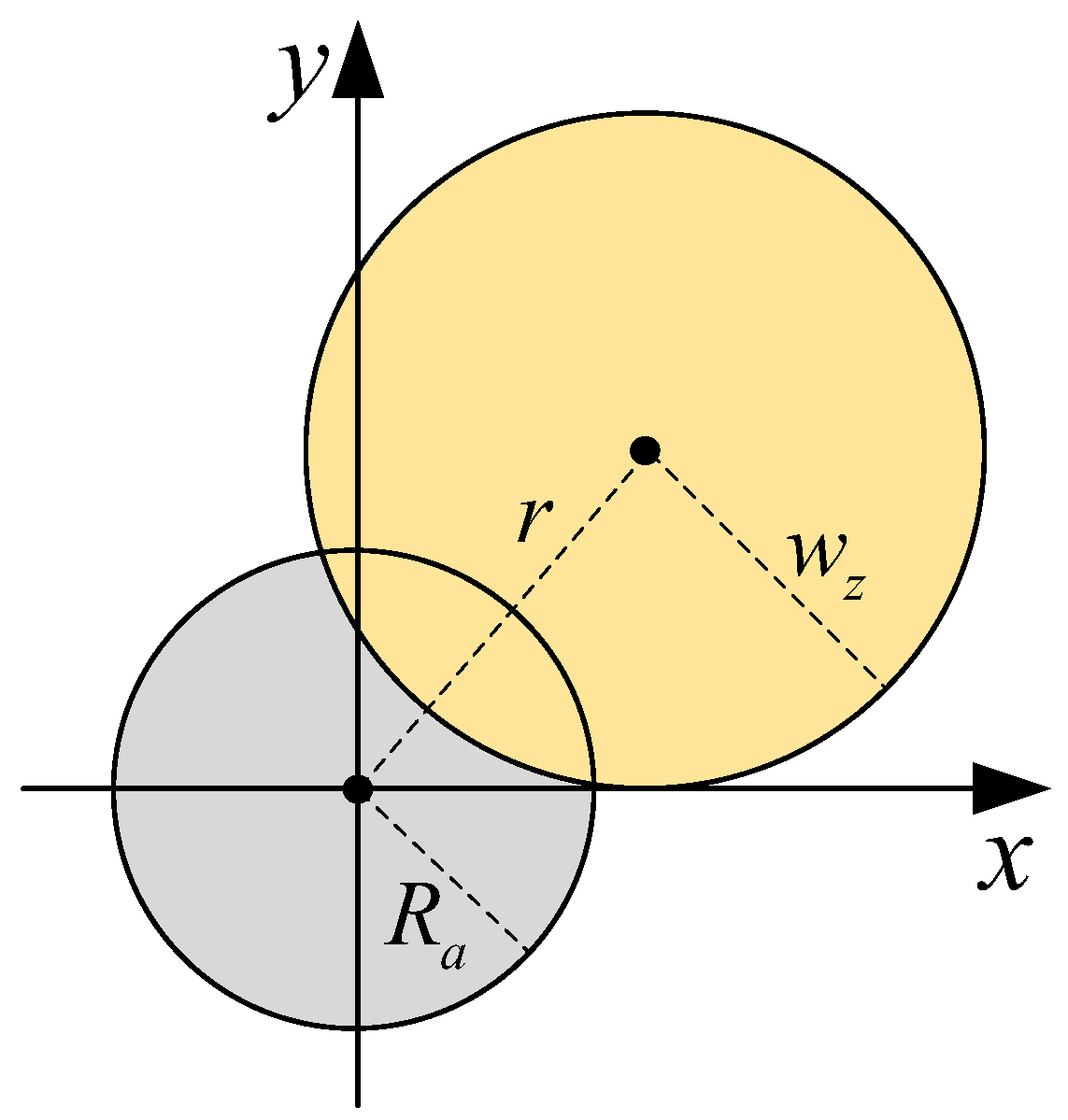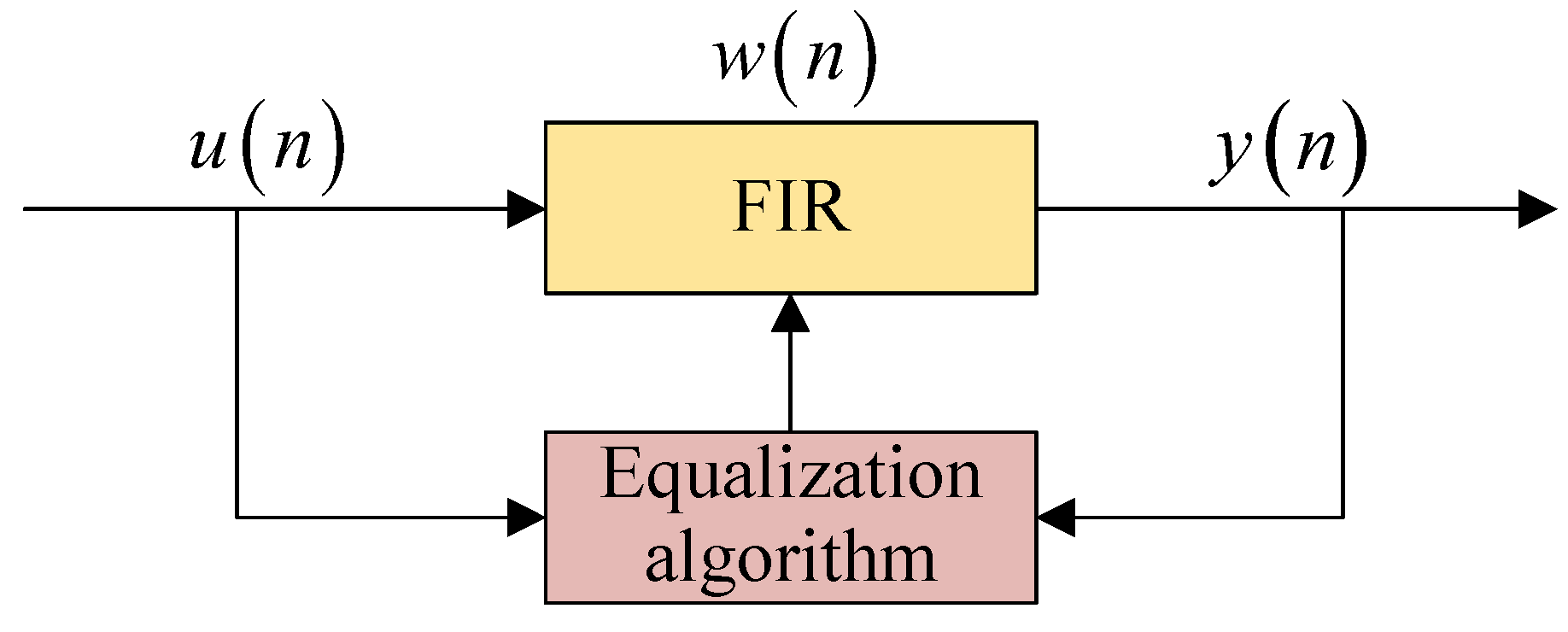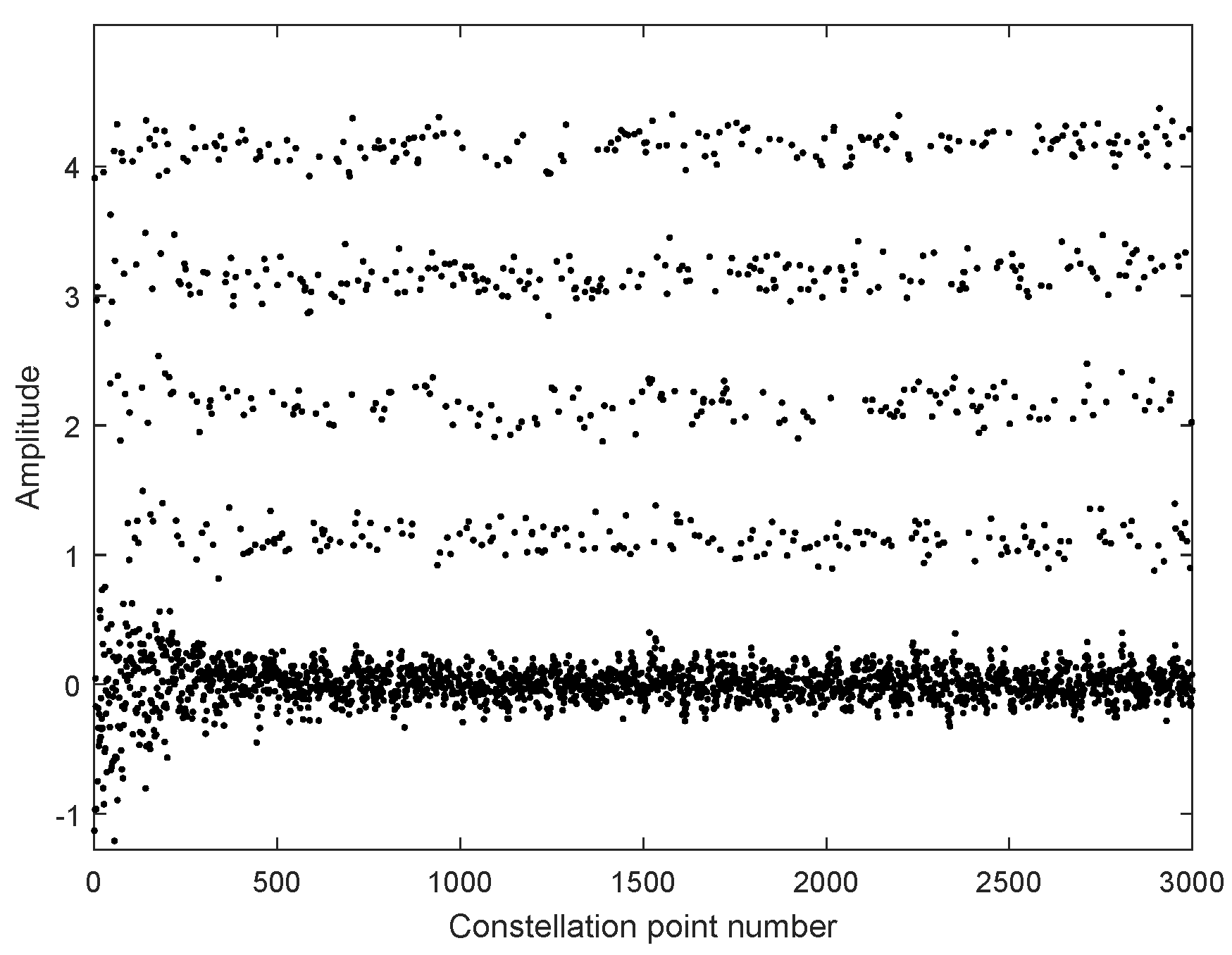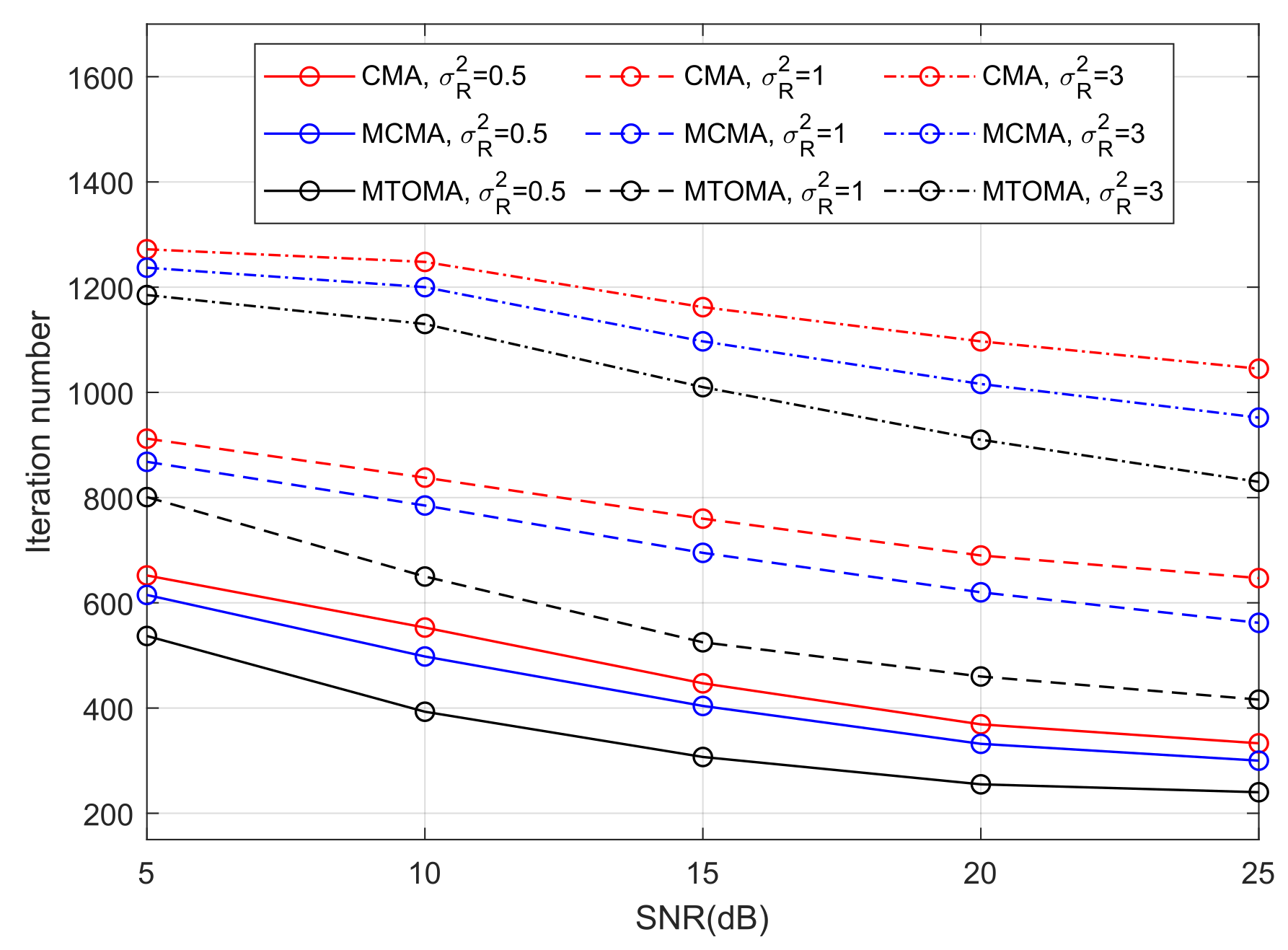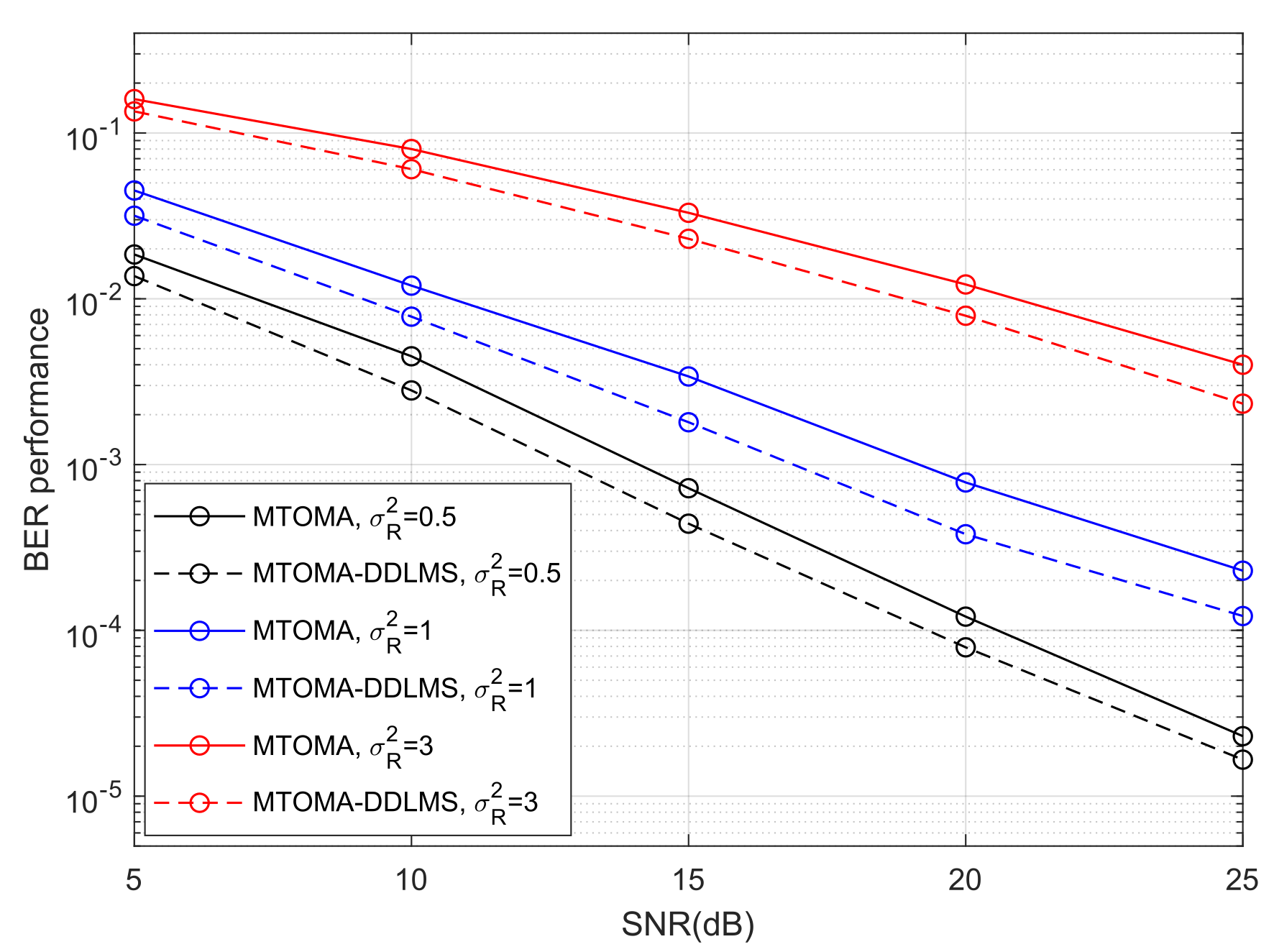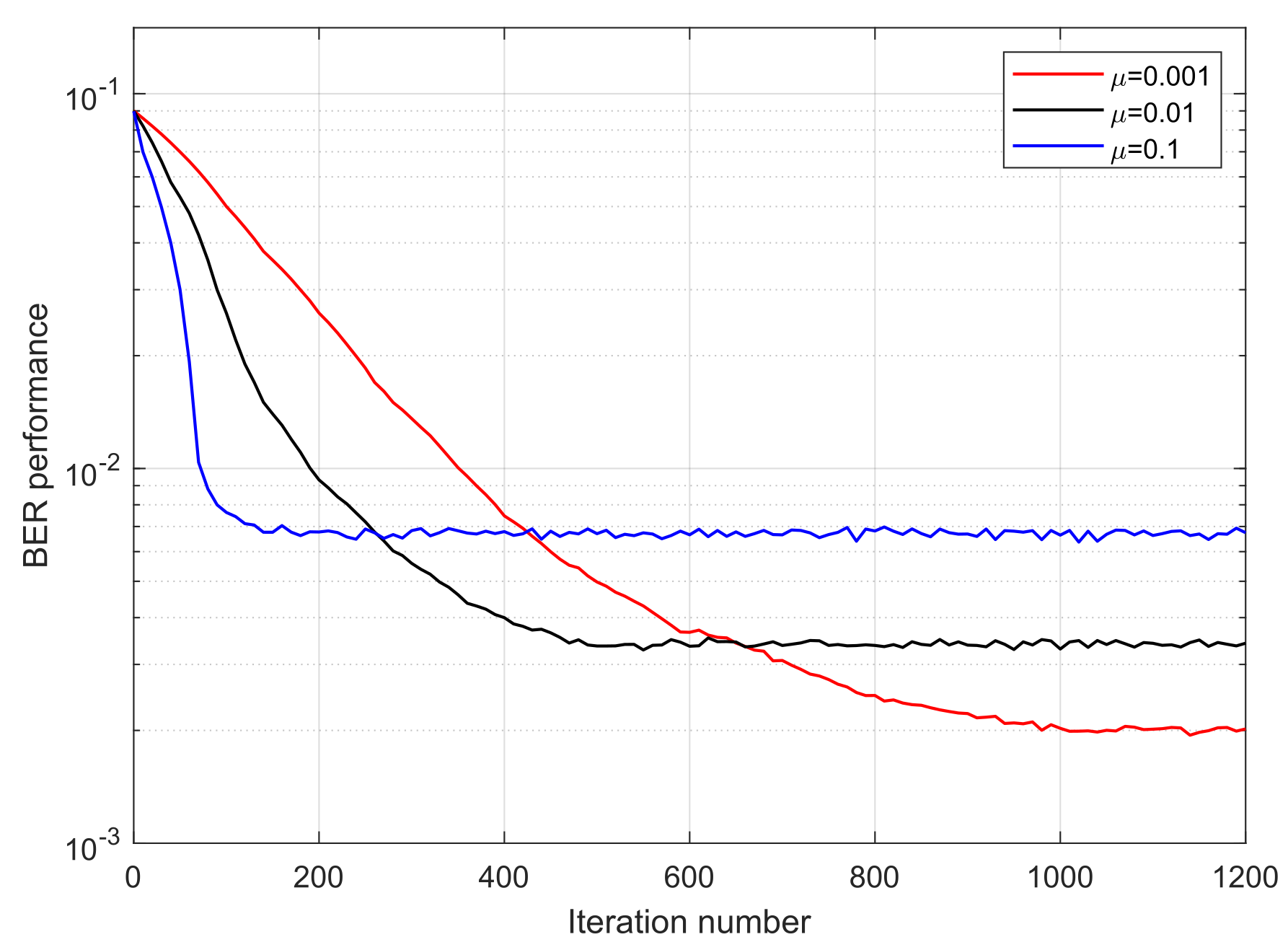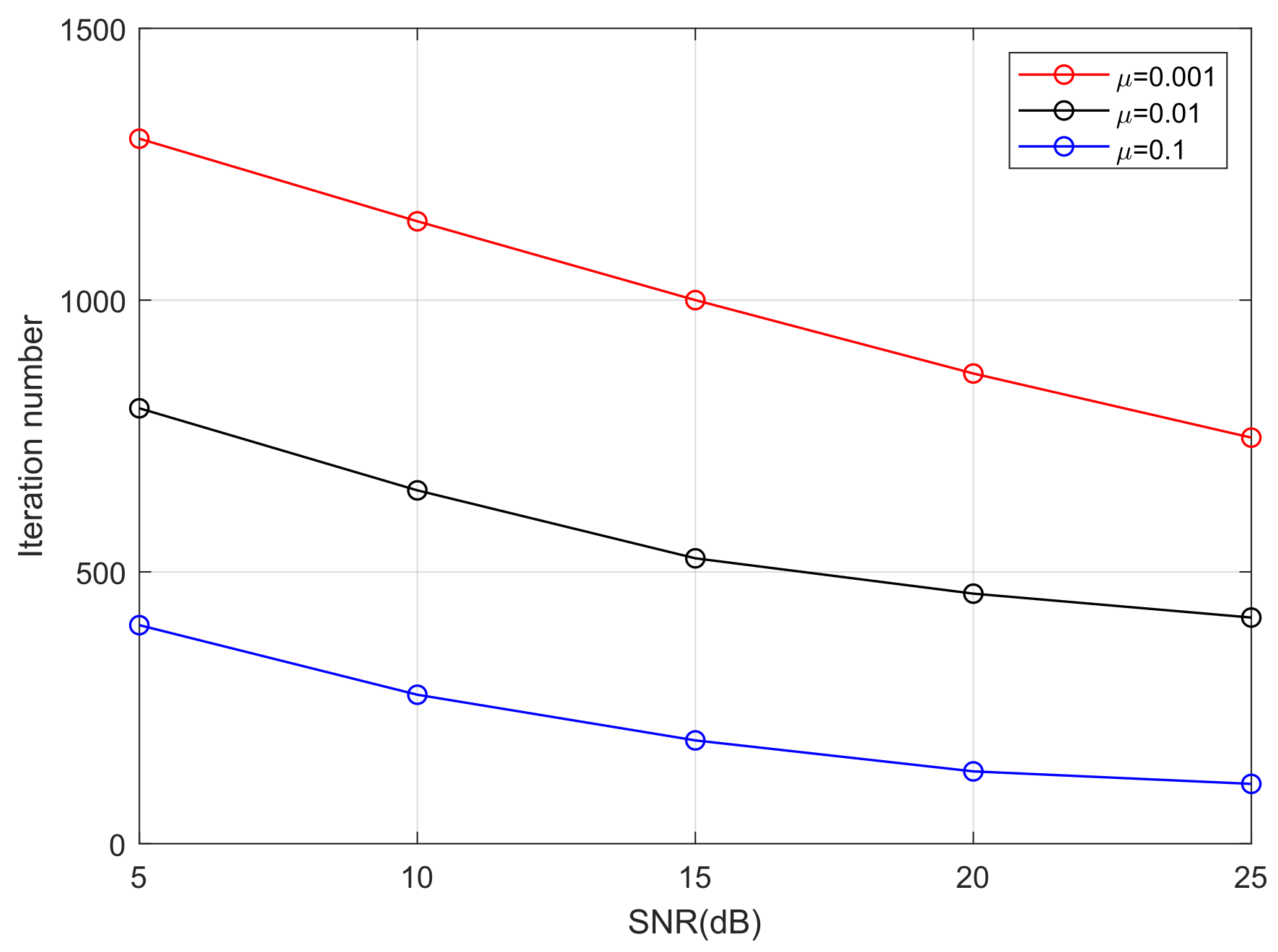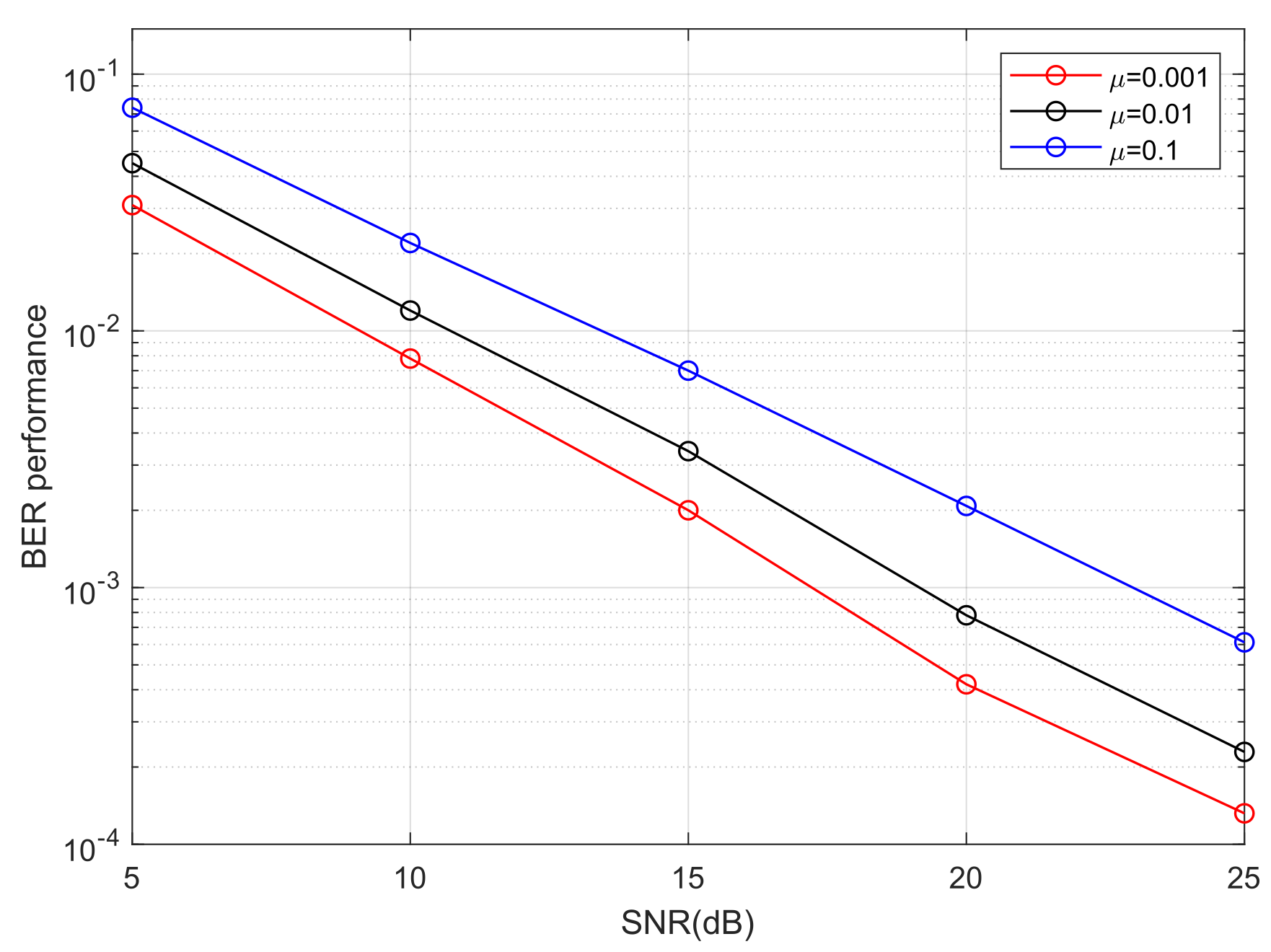1. Introduction
The rapid development of various applications of wireless communication has led to the requirement for ultrahigh-speed data transmission [
1]. The transmission rate of traditional microwave communication is insufficient to support the tremendous amount of data being transmitted, so novel wireless transmission technologies are urgently needed [
2,
3]. With its abundant bandwidth, fast transmission rate, good flexibility, and immunity to electromagnetic interference, free-space optical (FSO) communication is promising in terms of future wireless applications and has attracted substantial attention from researchers [
1,
2,
3,
4,
5]. Moreover, it has become the focus of research on sixth-generation (6G) technologies, which will further promote its development [
6].
Modulation is one of the core technologies in FSO communication, with the aim of loading information onto an optical carrier [
7], and contains intensity modulation–direct detection (IM-DD) schemes and coherent detection schemes. At present, IM-DD schemes are mainly used in practical applications, because they have a simpler structure and lower implementation complexity [
8]. IM-DD schemes include on–off keying (OOK), pulse position modulation (PPM), subcarrier intensity modulation (SIM), etc. [
9,
10,
11]. However, to perform optimally, OOK requires an adaptive threshold, and SIM has a complex structure, which can increase their implementation costs [
9,
10]. By contrast, PPM has potential because it balances implementation complexity and transmission performance, and also has high power efficiency, making it suitable for long-distance communication [
11].
However, when an optical signal propagates in atmospheric turbulence, it can be subjected to the turbulence effect, which is caused by irregular changes in atmospheric properties such as speed, temperature, pressure, and refractive index [
12]. The turbulence effect can induce aberrations in optical signals, such as intensity fluctuation and phase distortion [
12]. IM-DD systems utilize intensity to carry information, so intensity fluctuation is the primary factor affecting their performance [
12]. In microwave communication, equalization technology, a kind of digital signal processing (DSP) technique, is often utilized to reduce signal distortion because it can easily be integrated into the receiver [
13]. Generally, it uses a finite impulse response (FIR) filter to compensate for distortion and obtain the improved signals [
13]. Inspired by equalization technology, equalization algorithms have been utilized in IM-DD systems to mitigate the turbulence effect [
14,
15], and they have also been applied to PPM signals [
16,
17,
18,
19].
Ref. [
16] utilized the Viterbi equalization algorithm to improve the bit error rate (BER) performance of PPM optical signals in a turbulence channel, but the calculation formulas are quite complicated. Ref. [
17] utilized the minimum mean square error (MMSE) algorithm based on a training sequence to improve the transmission performance of PPM signals in FSO systems, but the training sequence reduced the transmission efficiency. Ref. [
18] utilized the decision-directed least mean square (DD-LMS) algorithm to reduce the distortion of PPM signals, but the convergence rate of DD-LMS is slow, and it cannot rapidly track the channel status. Ref. [
19] utilized constant modulus algorithm (CMA) equalization to mitigate the influence of the turbulence effect on PPM optical signals. It has a fast convergence rate and low implementation complexity, and does not need a training sequence. Meanwhile, it was found that, although PPM is not a constant modulus signal, the CMA can still improve its BER performance.
FSO communication is advancing in the direction of high-speed transmission, which is generally achieved by increasing spectral efficiency [
20]. However, the spectral efficiency of a PPM signal will decrease with an increase in the modulation order, so the traditional PPM format is not suitable for high-speed FSO systems [
21]. In order to improve PPM’s spectral efficiency, the multi-amplitude PPM format is proposed [
22], which is also known as pulse amplitude modulation—PPM (PAM-PPM). It can achieve a faster transmission rate than the traditional PPM format and better meet the needs of future high-speed FSO systems [
22].
However, a PAM-PPM optical signal is also limited in the face of high-speed transmission. Due to the turbulence effect, the refractive index of the atmosphere exhibits spatial inhomogeneity [
23]. In this case, an optical pulse can be regarded as a combination of several sub-pulses, and they can arrive at the receiver at different times [
24]. As the transmission speed increases, the pulse width of the PAM-PPM signal can become shorter in the time domain. Thus, in the time domain, the ratio of the inter-arrival time of sub-pulses to the pulse width can become larger, and then the overlap between sub-pulses can be reduced [
24]. In this situation, the intensity fluctuation of optical pulses will be more severe at the receiver, and the equalization algorithms will require more iterations to reach convergence [
24]. Therefore, it can be deduced that, for high-speed PAM-PPM optical signals, the system reliability will decrease with current CMA equalization. In order to improve the reliability of high-speed PAM-PPM optical systems in a turbulence channel, it is necessary to explore novel equalization algorithms that have faster convergence rates than the CMA.
Ref. [
25] demonstrated that the third-order moment algorithm (TOMA) used in the blind equalization process has convergence properties when processing asymmetric signals, and it has a faster convergence rate than fourth-order moment algorithms, such as the CMA. A PAM-PPM signal is actually an asymmetric signal, which will be proven in
Section 2. Thus, according to Ref. [
25], the TOMA used in the blind equalization process can be convergent when processing a PAM-PPM signal. However, we find that the PAM-PPM signal cannot be restored when TOMA reaches convergence. Therefore, on the basis of TOMA, we propose using a modified third-order moment algorithm (MTOMA) as a blind equalization scheme, which is able to restore the PAM-PPM signal under the convergence state, and the results are compared with the fourth-order moment algorithms.
In addition, for FSO communication, a pointing error will occur when the transmitter and receiver are not aligned. This can induce power attenuation at the receiver, affecting the transmission performance of the system [
26,
27]. Therefore, the pointing error is also considered in the atmospheric channel.
This paper is organized as follows. In
Section 2, the asymmetric characteristic of the PAM-PPM signal is proven, and the channel model combining atmospheric turbulence and the pointing error is established. In
Section 3, the principles of the MTOMA are introduced, and its performance is analyzed. In
Section 4, the simulations are conducted and discussed, and in
Section 5, the conclusions are drawn.
4. Simulation Results and Discussions
In this section, we take 4PAM-4PPM as an example to simulate the effects of MTOMA equalization on the
mPAM-
lPPM optical signal. For comparison, CMA and MCMA equalization are also simulated. The typical parameters of turbulence and the simulation conditions of the system are presented in
Table 2 and
Table 3, respectively.
The critical simulation values, which are given in
Table 3, are as follows: (1) The laser wavelength
is set to 1550 nm, because wavelengths around this value are less susceptible to the turbulence effect in engineering [
19]. (2) The optical-to-electrical conversion efficiency
is set to 1, because the
of APD can be approximately 1 when the laser wavelength is 1550 nm [
26]. (3) The displacement standard deviation
is set to 0.02 under normalized conditions, because under the control of current acquisition, tracking, and pointing (ATP) systems in FSO communication, the
of pointing errors is usually limited to 0.02 under normalized conditions [
31]. (4) The length of the FIR filter
is set to 15, because the equalization algorithms in this case can usually adapt to all turbulence conditions in practical applications [
40]. In addition, the initialization
is set to
, which is the standard setting in FSO engineering applications [
40]. (5) The step size
is set to 0.01, which can usually maintain a good balance between convergence rate and BER performance in practical systems [
40].
In addition, the signal-to-noise ratio (SNR) in this section is defined as the received SNR in the electrical domain, which is given by
, and
is the variance of AWGN. Based on this definition, which is also given in Ref. [
41],
can be regarded as the received signal power, and
can be regarded as the noise power [
41]. Therefore, according to the simulation conditions in
Table 3, we can derive
, so the SNR can be expressed as
.
In
Figure 6, we take moderate turbulence (
) as an example to simulate the constellation points of 4PAM-4PPM in the atmospheric channel. The constellation points are quite scattered under the influence of the turbulence effect. If they are directly used for symbol decision, a high BER is inevitable. Thus, equalization is necessary. The constellation points with MTOMA equalization are presented in
Figure 7. It can be seen that, in the early stage of the equalization process, the constellation points converge, and when the MTOMA reaches convergence, they are effectively separated in terms of amplitude. This indicates the effectiveness of MTOMA equalization. In addition, the optical signal suffers from attenuation because of the pointing error, and according to the simulation conditions in
Table 3, the signal amplitudes at the receiver are reduced by half compared with those at the transmitter.
The BER performance of 4PAM-4PPM based on CMA, MCMA, and MTOMA equalization is presented in
Figure 8. Notably, here, “BER performance” represents the BER level of current constellation status in terms of a certain iteration number, rather than the overall BER statistic of the signal. It can be seen that BER performance with the MTOMA is superior to that with the CMA and MCMA under the same iteration number. Thus, BER performance with the MTOMA decreases the fastest in the early stage of the iterative process, and after approximately 530 iterations, it is nearly stable. In contrast, BER performance with the MCMA and CMA is stable when the iteration numbers are about 700 and 750, respectively. Therefore, the MTOMA has a faster convergence rate than the MCMA and CMA when the PAM-PPM signal is processed.
It can be seen from
Figure 9 that turbulence intensity has a significant impact on the convergence rate of algorithms. When the algorithms reach convergence, there are considerably fewer iterations in weak turbulence than in strong turbulence. For example, as the Rytov variance
varies from 0.5 (weak turbulence) to 3 (strong turbulence), the iteration numbers of the MTOMA, MCMA, and CMA increase to about 700, 690, and 720, respectively, when SNR = 15 dB. In addition, if SNR and
are fixed, the convergence rate of the MTOMA is faster than that of the MCMA and CMA, and the gap is the most obvious in moderate turbulence (
). For example, when SNR = 15 dB, there are about 170 and 230 fewer iterations when using the MTOMA than when using the MCMA and CMA, respectively, in moderate turbulence. In contrast, these values are about 100 and 140 in weak turbulence, and 90 and 150 in strong turbulence.
The BER performance of 4PAM-4PPM under different turbulence conditions when algorithms converge is shown in
Figure 10. BER performance can be significantly impacted by turbulence intensity, and it will decrease with an increase in
. When SNR = 15 dB and
varies from 0.5 to 3, BER performance when using the MTOMA, MCMA, and CMA decreases by 16.6 dB, 16.3 dB, and 15.8 dB, respectively. If SNR and
are fixed, BER performance when using the MTOMA is superior to that when using the MCMA and CMA, and the gaps between BER performance values are the largest in moderate turbulence. For example, when SNR = 20 dB and
, the BER performance gaps are 1.7 dB and 6.5 dB, respectively, between the MTOMA and the other two algorithms. In contrast, the gaps are 1.4 dB and 4.3 dB when
, and 1.5 dB and 4.8 dB when
.
Figure 9 shows the iteration numbers when the MTOMA reaches convergence, according to which we can continue to utilize the DDLMS, and BER performance is presented in
Figure 11. When SNR and
are fixed, BER performance with the MTOMA-DDLMS is superior to that with the MTOMA under different turbulence conditions. Therefore, the dual-mode equalization algorithm MTOMA-DDLMS further improves the BER performance of the PAM-PPM signal compared with the MTOMA. In addition, the effect of the MTOMA-DDLMS is the most significant under moderate turbulence conditions. For example, when SNR = 15 dB, BER performance with the MTOMA-DDLMS can increase by 2.8 dB compared with the MTOMA in moderate turbulence. By comparison, the BER performance gains are 2.1 dB and 1.6 dB, respectively, in weak and strong turbulence. When SNR = 20 dB, the BER performance gains are 1.8 dB, 3.1 dB, and 1.9 dB, respectively, in weak, moderate, and strong turbulence.
We take moderate turbulence (
) as an example to analyze the influence of step size on PAM-PPM optical signals in an atmospheric turbulence channel.
Figure 12 and
Figure 13 demonstrate that step size has a significant impact on the convergence rate of the MTOMA. When SNR is fixed, as the step size increases, the convergence rate will increase; however, according to
Figure 14, BER performance under convergence will decrease, and different application scenarios may require different step sizes.
For real-time data transmission scenarios, such as voice calls, a fast convergence rate is required to reduce call drops and delays [
42]. In addition, when the channel conditions change frequently, a fast convergence rate is also required to rapidly adapt to the channel variation [
43]. For example, in military applications, when unmanned aerial vehicles (UAVs) are constantly moving, UAV-based FSO systems must quickly track channel variation to keep transmission links stable [
44]. Moreover, when FSO communication is used in a marine environment, a fast convergence rate is also necessary because atmospheric turbulence can change frequently [
45]. In these situations, large step sizes tend to be required. For transmission scenarios with stable channel conditions, such as high-definition (HD) video transmission between satellites and the ground, and television signal transmission in cities, high BER performance may be the most important factor [
46]. In these situations, small step sizes tend to be required.
5. Conclusions
In this paper, a blind equalization scheme based on the MTOMA is proposed to mitigate the influence of the turbulence effect on PAM-PPM optical signals, which represents a promising avenue for future high-speed FSO communication. Through theoretical analysis, it is found that the MTOMA is more robust to noise compared with the current fourth-order moment algorithms, such as the CMA and MCMA. Meanwhile, the MTOMA will not increase the implementation complexity compared with the CMA and MCMA; in particular, it has fewer multiplication operations, which is crucial, because it indicates that the MTOMA has faster computation speed for hardware implementation.
These simulation results show that the MTOMA is effective in reducing the distortion of PAM-PPM optical signals in atmospheric turbulence channels with pointing errors. Under different turbulence conditions, the MTOMA has a faster convergence rate than the CMA and MCMA. For example, when SNR is 15 dB, the MTOMA requires about 530 iterations to reach convergence in moderate turbulence, which is about 230 and 170 fewer iterations than required by the CMA and MCMA, respectively; the differences in the number of iterations required by the MTOMA and those required by the CMA and MCMA, respectively, are about 140 and 100 in weak turbulence and 150 and 90 in strong turbulence. Moreover, when algorithms converge, the BER performance of the PAM-PPM signals with MTOMA is also superior to that with CMA and MCMA. For example, when SNR = 20 dB, the BER performance of the PAM-PPM signals with MTOMA improves by 6.5 dB and 1.7 dB, respectively, compared to that with CMA and MCMA in moderate turbulence, and this value improves by 4.3 dB and 1.4 dB in weak turbulence and 4.8 dB and 1.5 dB in strong turbulence. Therefore, the reliability of the PAM-PPM optical system with the MTOMA can be enhanced. In addition, the dual-mode algorithm MTOMA-DDLMS further improves BER performance compared with the MTOMA.
The current study is based on theoretical analysis and simulation, and some assumptions are made in channel modeling. In the near future, real-world FSO experiments will be conducted to further verify the feasibility of the MTOMA in PAM-PPM optical systems, and the proposed scheme will be continuously enhanced in practical experiments. Meanwhile, future research may include the following aspects. Firstly, a variable step size scheme can be combined with the MTOMA to improve flexibility and adaptability in time-varying channels. Secondly, channel coding technology, such as current Polar codes and LDPC codes, can be combined with the MTOMA to further improve the BER performance of PAM-PPM optical systems in strong turbulence conditions. Thirdly, the MTOMA may be extended to other asymmetric signals with high spectral efficiency, such as polarization–division–multiplexed PAM-PPM (PDM-PAM-PPM).


